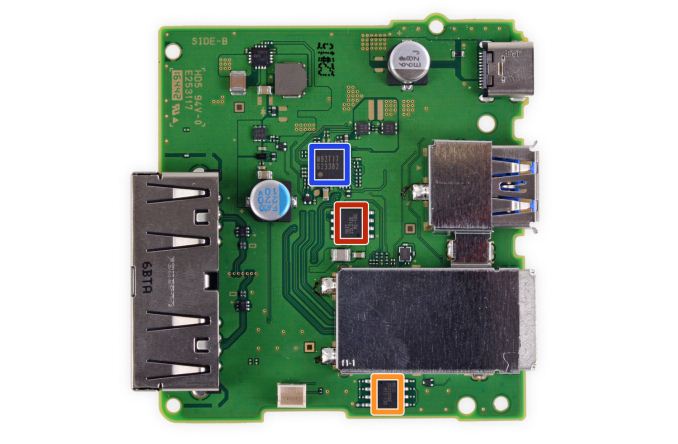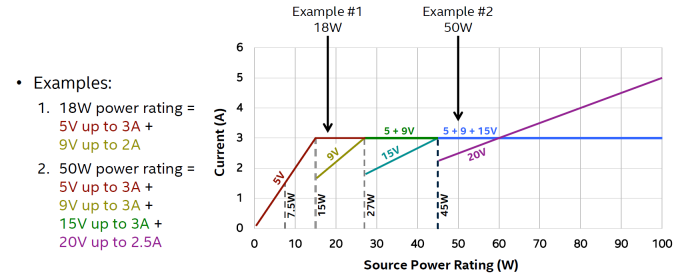Playing With Power: A Look At Nintendo Switch Power Consumption
by Ryan Smith on March 6, 2017 12:00 PM ESTGetting Nerdy: USB Power Delivery 2.0
Now to understand why this is, we need to talk a bit about the USB Power Delivery Specification 2.0, which is closely tied to USB-C. PD 2.0 establishes a series of voltages, depending on how many Watts a sink device needs. Furthermore it also defines the Amperage limits at each of these voltages (and in special cases when you can exceed them).
In short, PD 2.0 defines 4 voltages: 5V, 9V, 15V, and 20V (and a fully optional 12V mode). USB-C cables, in turn, must be able to carry 3 Amps. As a result, you end up with the following ranges.
After you reach 3A at a given voltage, if a device still needs more power it should switch up to the next voltage if it’s available and the device can accept it. The Switch’s own power adapter of course likes to run at 15V, and I’ve also confirmed that the console will take 9V and 5V.
For whatever reason, Nintendo seems to limit the Switch to pulling 2A, regardless of the voltage. There’s nothing wrong with this – it just is – but it does influence how well third party power adapters and power banks can power the Switch. Anything that can only deliver 5V, such as a power bank, low-end charger, or most laptops, will max out at 10W before cable losses. Again, this is sufficient to run the undocked Switch, it just means it can’t charge while it’s running.
The one downside here with respect to power banks is that, to the best of my knowledge, none of them support USB Power Delivery with 9V or better. Because only a handful of USB-C devices even take more than 5V, this is sufficient to charge phones, tablets, and even to slowly charge a MacBook. So until someone comes out with a power bank that supports USB-PD’s higher voltage modes, 10W appears to be as quickly as you can charge a Switch. Update: It turns out that RAVPower is shipping a rather sizable 99 Whr power bank that does support higher voltage modes, their 26800mAh USB Type-C pack. So if you need a pack that can play and charge the Switch at the same time, this should be able to do the trick. The one downside is that they don't currently offer a multi-voltage power bank in any other capacities.
USB Type-C Cables: 2.0 versus 3.0/3.1
On a quick aside, I’ve seen a few questions about what kind of USB Type-C cable is needed to connect the Switch to a power bank or third party charger, whether it needs to be a “2.0” cable or a “3.1” cable. The good news is that as long as the cable is built to specification, any cable will work.
The USB specification requires that all standard/passive USB-C cables be able to carry at least 3A, regardless of their data speed. So for charging purposes, a good cable is a good cable. And this goes for 9V/15V/20V chargers as well.
In fact the only reason there are even different cables is due to a combination of cost optimizations and a desire to allow thinner, more flexible cables. USB SuperSpeed (3.0) and SuperSpeed+ (3.1 Gen 2) signaling requires a relatively thick cable to properly conduct the signal and shield the high speed lanes. USB 2.0 on the other hand is a much simpler and slower signaling standard, which in a USB-C cable uses a different set of wires altogether. As a result a USB-C 2.0 cable can forgot the high speed lanes, making it a lot thinner. Just bear in mind that as handy as a thin USB-C 2.0 cable is, you will need a USB-C 3.0/3.1 cable if you want to get those data rates between devices.
Yes, You Can Use Third Party Power Adapters
As for third party power adapters, those will easily work with the Switch. As long as they support USB Power Delivery you should be good to go. I’ve tested the Switch with the adapters I have on hand – which all happen to be Apple adapters – and it works exactly as you’d expect. However keep in mind that you’ll want at least a 15V adapter if you want to match Nintendo’s stock power adapter's capabilities.
| Switch Power Consumption: Third Party Power Sources | ||||
| Charging (Sleep) | ||||
| Apple 87W USB-C Adapter | 9.6W (8.88V @ 1.08A) |
|||
| Apple MacBook Pro 15" (2016) | 7.1W (4.8V @ 1.47A) |
|||
Also, it should be noted that a larger adapter will not charge the Switch any faster, even at 15V. The tablet itself can charge at a peak rate of 10W, and no faster. The Nintendo adapter can give the Switch all it can handle, so the only purpose of additional adapters are for portability and better charging rates with other, higher-power devices.
But No, You Can’t Use Third Party HDMI Adapters
Finally, while I wasn’t expecting this to work in the first place, I also tried the Switch with third party HDMI adapters. As a quick refresher, the Switch natively outputs DisplayPort over its USB-C port, which is then converted to HDMI inside the dock. So, on paper, any adapter similar to the Dock should work with the Switch.

The Switch Dock's PCB (Image Courtesy iFixit)
However it would seem that Nintendo isn’t going to allow this. Attempting to use Apple’s Digital AV Adapter – which for all practical purposes is as close to the Switch Dock in functionality as you’re going to find – was rebuffed by the Switch. The Switch wouldn’t even charge with Apple’s adapter in the chain, let alone output HDMI. And no other adapter had any more luck. So if you want to get HDMI out of your Switch, then you’re going to need to use Nintendo’s official Dock (at least until they start approving third party docks).
Finally, a quick shout-out to Patrick for the best article title submission: "The Old Switch-eroo: How to charge Nintendo's newest console"











61 Comments
View All Comments
julian- - Monday, March 6, 2017 - link
Interesting, though I spent an age trying to persuade a Switch to charge from 5V sources with an A-C cable and it refused to pull more than 0.5A from any of them. Were all your tests with Type-C chargers/power banks and C-C cables?Ryan Smith - Monday, March 6, 2017 - link
Yes, they were are C-to-C.julian- - Tuesday, March 7, 2017 - link
Ah, might want to clarify that on page 2, as the following paragraph was definitely not true when I tried with an A-C cable from a good (2.4A) Anker power bank (and even the Switch's own dock)."what I’ve found is that any good power bank designed to power tablets will be sufficient to power the Switch. So long as a bank can deliver 5V @ 2A or better, then it can power Nintendo’s console."
Also, while the battery itself isn't so badly designed that he recommended they stop selling it immediately because it's dangerous (unlike the wall charger it comes with..), USB-PD guru Nathan K isn't so hot on your recommendation:
https://plus.google.com/102612254593917101378/post...
https://plus.google.com/102612254593917101378/post...
Visual - Tuesday, March 7, 2017 - link
wow, so people care about power use for such a device? it seems absolutely irrelevant to me.how about an actual review, showing what this gadget can run and how well?
whowantscake - Tuesday, March 7, 2017 - link
People care, because you want to know what chargers are compatible with the Switch. You want to know which chargers communicate with the Switch and provide more amps than just a trickle. This article also shows that the 5V profile appears to be not fully utilized, so chargers that have a 9V or 15V are able to provide up to the Switch's limit.What is irrelevant to you is relevant to plenty of Switch owners. We want chargers and battery packs that can provide enough juice to charge while playing undocked, not just slow down the battery drain. This article will help a lot of people buy the most appropriate chargers and battery packs. Helping everyone people advance their understanding of USB-C in general, is great.
Chidoro - Monday, January 8, 2018 - link
Have you provided Anand with your list of what is important to you yet? I’m sure the side doesn’t want to encounter any additional misstepswhowantscake - Tuesday, March 7, 2017 - link
The article tested numbers were very similar to this reddit user's quick tests (link below). He pulled ~16.5W in-line from the Nintendo AC adapter. He pulled 18W from the Google Pixel charger, which was great news to me, as I've got several already. I highly recommend it to anyone reading comments here. It packs small, and comes with a 6' cord, and the cord & charger have passed rigid usb-c spec testing.Knowing the 9V profile can provide the maximum 18W means I'll be making sure that the batter charging pack I pick covers it. It'll be a bonus that I can also recharge the Pixel XL at the full rate.
Thanks for the article. It's great having someone putting out good information with the testing method spelled out. Maybe, just maybe, it'll help /r/nintendoswitch to stop passing around poor information and recommendations for chargers and battery packs. USB-C has been a nightmare for consumers to understand.
https://www.reddit.com/r/NintendoSwitch/comments/5...
dchengster - Tuesday, March 7, 2017 - link
Great work delving into this. As I read your article I thought of my Dell Laptop Power Supply as well as Dell's Laptop Powerbank which outputs in both 5V USB and has a special connector to output in 19.5V. A quick search led me to Dell's 7.4mm Barrel to USB-C adapter on the Dell site. Spec's say it supports 5V/20V, I'll be ordering one to test.. anything to save from packing more power adapters or powerbanks.http://accessories.dell.com/sna/productdetail.aspx...
dchengster - Tuesday, March 7, 2017 - link
A 4.5mm power connector to USB-C version is also available:http://www.dell.com/en-us/shop/accessories/apd/470...
sonicmerlin - Tuesday, March 7, 2017 - link
I want a Switch but the idea of 3 of hours battery life is pretty disappointing, Hopefully a node shrink in a Switch "Pro" version in a year or two will increase battery life.